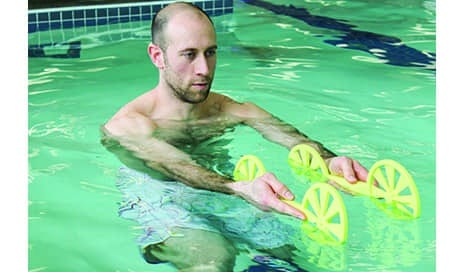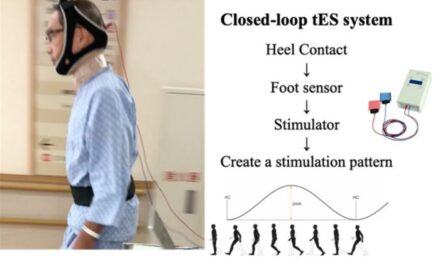
Resistive paddles can be used for water-based activity that strengthens the core and upper extremities. Occupational and physical therapists use aquatic therapy as a dynamic treatment technique to maximize a patient’s functional potential.
by Susan Goldstein, PT
“I was never able to exercise until I did aquatic therapy.”
“This is the first time I feel free to move with little pain.”
Expressions such as these can be heard from patients who experience what they sometimes refer to as the “magical” effects of aquatic therapy. These patients sometimes have found they are able to walk in the water after unsuccessful attempts to ambulate on land due to weakness and pain limitations. Gaylord Specialty Healthcare, Wallingford, Conn, designed its aquatic facility and specialized programs with the aim of regularly providing these types of experiences for patients who receive treatment there.
Gaylord is a 137-bed long-term acute care hospital and outpatient rehabilitation center that specializes in medical management and rehabilitation for patients who are affected by an acute illness or are recovering from a traumatic accident. The facility’s aquatic therapy program was put in place to help distinguish Gaylord and uses the power of water to relieve pain, strengthen muscles, and improve function.
The program has transformed in scale and sophistication since beginning in 1987 at a local YMCA pool. In 1992, a state-of-the-art 75-foot x 25-foot therapeutic pool was built in a new addition of Gaylord hospital which is now utilized by physical therapists, occupational therapists, speech therapists, and therapeutic recreation staff to treat inpatients and outpatients. Gaylord also offers Aquacize, a community-based program that offers independent aquatic exercises and group classes. Further expanding the program in 2006, a satellite facility, Gaylord Physical Therapy Orthopedics and Sports Medicine, was built in North Haven, Conn, in 2006, and houses a 10-foot x 20-foot therapy pool, a 75-foot x 20-foot fitness pool, and a whirlpool.
The Pool Population
Aquatic therapy can provide benefits to an array of patients affected by varying orthopedic and neurological conditions, with consideration of precautions and contraindications. These diagnoses include acute and chronic pain, arthritis, stroke, multiple sclerosis, brain injury, postsurgical, quadriplegic and paraplegic spinal cord injuries, Parkinson’s disease, amputations, joint replacement, sports-related injuries, obesity, Guillain Barré syndrome, lymphedema, and cerebral palsy.
Used by occupational and physical therapists to maximize their patients’ functional potential, aquatic therapy has come into use as one of the most dynamic treatment techniques. Utilizing the natural properties of water in combination with various techniques, water-based rehabilitation is a beneficial treatment option that helps patients meet their therapy goals as well as their personal goals. Depending on the severity of the diagnosis, some patients receive additional land-based physical therapy to accompany their aquatic therapy.
Why it Works So Well
There are numerous therapeutic benefits associated with exercising in water, including reduced pain, increased strength, maximized cardiovascular levels, increased gait ability, improved stand tolerance, increased body awareness, increased balance and coordination, decreased spasticity, and functional mobility gains. The psychological benefits of exercise in water include a sense of well-being, relaxation, decreased fear of reinjury, and freedom of movement. With the temperature of Gaylord’s therapy pools maintained at 90°F to 94°F, there are also physiological gains from immersion which include the following: increased superficial circulation, decreased edema, increased blood supply to muscles, increased heart and respiratory rate, muscle relaxation, and increased general metabolic rate. Athletes with sports-related injuries exercise in the fitness pool maintained at approximately 84°F to avoid overheating.
Understanding the physical properties of water and how they affect movement can maximize outcomes. Hydrodynamic properties include buoyancy, hydrostatic pressure, viscosity, and resistance. Buoyancy is based on Archimedes’ principle, which states that there is an upward and equal force equivalent to the fluid that the body has displaced. Movement toward the surface of the water is assisted, movement away from the surface is resisted, and movement on the surface of the water is supported. During static standing in waist-level water, there is 50% weight bearing of the body, 20% to 30% weight bearing in chest-level water, and 10% weight bearing at the cervical level. However, with fast walking, there is increased ground reaction force resulting in increased weight bearing. Treatment in water is the ideal environment to decrease gravitational forces on a painful spine and to walk with a patient with specific weight bearing precautions.
Buoyancy
Patients realize increased mobility in the water in opposition to gravity’s forces. Buoyancy supports body parts, providing unloading of the spine and limbs with deep water vertical distraction and stabilization, facilitating pain relief and core strengthening. Exercise in water can decrease joint stress and maximize ease of moving a painful spine or limbs, which reduces protective muscle spasms and guarding. This results in increased range of motion and function. To optimize strength, a therapist can use buoyancy and resistance to help support, assist, or resist their patients’ movement, allowing progression of resistance in a graded fashion. This is especially helpful with return-to-sport training when plyometric exercises are reintroduced. Buoyancy reduces the ground reaction forces by up to 50% with eccentric landing to allow athletes to improve motor control without reproduction of pain.
Hydrostatic Pressure
Hydrostatic pressure is based on Pascal’s law, which states that fluid pressure is exerted equally on all surface areas of an immersed body at rest at a given depth. Fluid pressure increases with density and depth. This pressure increases for every foot of water, so when a patient is exercising in chest-level or above, there is maximal pressure on calf muscles. This assists with venous blood flow and decreases edema, which is commonly associated with acute injury, postsurgery, and lymphatic dysfunction. Water provides resistance to the muscles of inspiration; cardiovascular output is increased because it is twice as challenging to breathe in water than on land.

Overhead sling lift in use at Gaylord Specialty Healthcare’s therapy pool. An ADA-compliant lift can help accommodate safe entry and exit for patients who participate in water-based programs.
Viscosity
Viscosity is defined as the resistance of a fluid to flow. The viscosity of water, or the drag force, slows the rate of falling and allows more time for balance recovery. Combined with buoyancy, viscosity improves righting reactions and enables patients to improve high-level balance skills without worry of injury. This results in increased confidence and safety of mobility in various settings. The property of viscosity stimulates the skin receptors and muscle spindles, resulting in greater sensory and proprioceptive awareness during movement.
Resistance
Resistance in water includes both surface tension and frontal resistance. The aquatic environment offers co-contraction and multidirectional resistance not reproducible on land. Movement through the water can be streamlined or turbulent, fast or slow, varying the level of challenge for patients. Limbs can move in and out of the water, thus breaking surface tension and creating more resistance. It is interesting to note that water is 40% to 60% more resistive than air. When moderate pain is present, slow and streamlined movements are initially performed. A therapist can adjust the position of a patient’s extremity or spine, change the amount and type of streamlined versus nonstreamlined flow of movement, and change the speed using turbulence to match a patient’s strength and pain level. The length of the lever arm and turning forces also affect resistance, especially with the addition of resistive equipment. Drag forces of water are decreased when the physical therapist walks in front of the patient. This decreases the resistance and increases the flow of movement through the water. Swim strokes can be utilized to develop integration of bilateral sides of the body and perform reciprocal limb movement.
Creative and Adaptive
Proper posture in the water is emphasized, combined with deep water cycling, vertical spinal stabilization, and resistive arm exercises to stimulate core strength. Deep water exercises are used to improve slow twitch muscle endurance and cardiovascular health. These exercises can be especially helpful with patients affected by chronic pain, allowing them to exercise for prolonged periods of time while minimizing fear avoidance to movement. Studies of aquatic plyometric exercise programs have demonstrated decreased severity of delayed onset muscle soreness (DOMS) due to lower levels of creatine kinase when compared to land-based resistive exercise.
Gaylord’s aquatic staff is proficient in a variety of specialized aquatic approaches, including manual techniques such as Bad Ragaz, Watsu, and Halliwick, Ai Chi, as well as functional training, spinal stabilization, and plyometrics. These techniques can be adapted as needed with consideration of the patient’s abilities. The Gaylord pool staff attends lifeguard training classes and aquatic therapy continuing education classes to further their knowledge of advanced techniques.
Equipped for Performance
Some unique features of Gaylord’s pool facilities include specialized equipment for entry, such an overhead sling transfer lift. This lift accommodates patients up to 600 pounds and can allow assisted gait while in the sling. There is a hydraulic seat lift which accommodates patients up to 500 pounds, as well as stairs with rails to enter the pool. Along half of the perimeter of the pool, there is a 2-foot-wide raised ledge at wheelchair seat height. This allows advanced patients to transfer and perform a sit-dive entrance into the water. A seat bench is set at 2.5-foot depth for seated balance, cardio ex’s, and stretches. Accommodating safe entry and exit for users to enter and exit the water is an important part of water-based therapy, and ADA-approved pool lifts are available from several manufacturers to provide for this.
The pool used at Gaylord has warm water jets located at various spots along the wall to massage and relax the spine and extremities. Along the edges of the pool there is a cutout area to allow easy grip with one’s hand or forearm for support with gait training and exercise. Today’s pool manufacturers offer other features designed to enhance function and performance which can expand the possibilities therapists have for designing therapeutic activity. Among these features are underwater treadmills, resistance currents, and camera systems that can monitor activity below the waterline.
Various aquatic equipment is utilized during treatment, including a deep water exercise station for pull-ups and push-ups, step benches of varied heights for balance exercises and plyometrics, buoyancy cuffs, Velcro weights, and resistive wings for lower extremities, resistive arm equipment (paddles, barbells, dumbbell floats of varied thickness, and webbed gloves), noodle floats, buoyancy belts, and cervical collars. Kayaks are put to use by therapeutic recreation staff to enable patients to practice skills that can be used in open water.
Versatile Therapy
Treatment and exercise in a therapeutic pool have been shown to exhibit many advantages for the facility’s patients. Aquatic therapy can be utilized solely as a therapeutic treatment plan or as an adjunct to land-based treatment. The benefits of aquatic therapy treatment can aid patients both physically and psychologically, improving their overall function and helping to achieve their goals. RM
Susan Goldstein, PT, was one of the founders of the aquatic therapy program at Gaylord Specialty Healthcare. She has more than 30 years of experience working in the field of aquatic therapy. For more information, contact [email protected].





Thank you for your outstanding article about Gaylord Specialty Healthcare’s pool and Aquatic Therapy Program at the hospital in Wallingford, CT and at Gaylord Physical Therapy Orthopedics & Sports Medicine in North Haven, CT. We appreciate the detailed information this article provided about the many benefits of aquatic therapy. For more information on our programs please see our website at: http://www.gaylord.org
Thank you for this outstanding article about Gaylord Specialty Healthcare’s pool, our Aquatic Therapy Program at hospital in Wallingford and our Physical Therapy Orthopedics & Sports Medicine location in North Haven, CT. The information detailing the benefits of aquatic therapy were excellent. For more information please see our website at http://www.gaylord.org.
It was our pleasure to publish this article. Sue Goldstein is a seasoned veteran of this particular type of therapy, and we are grateful that she was willing to share her insights.
–Editor